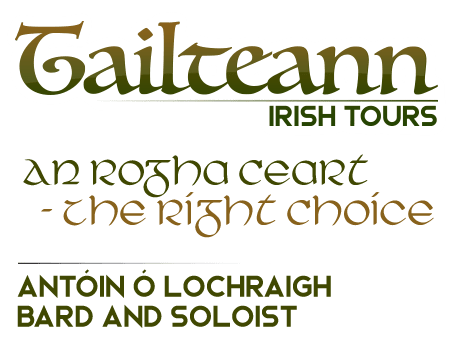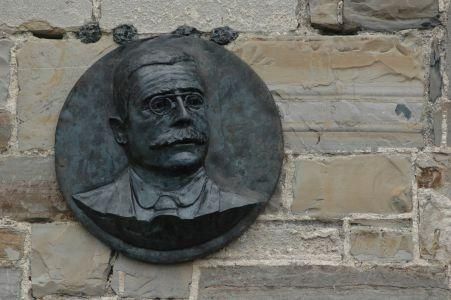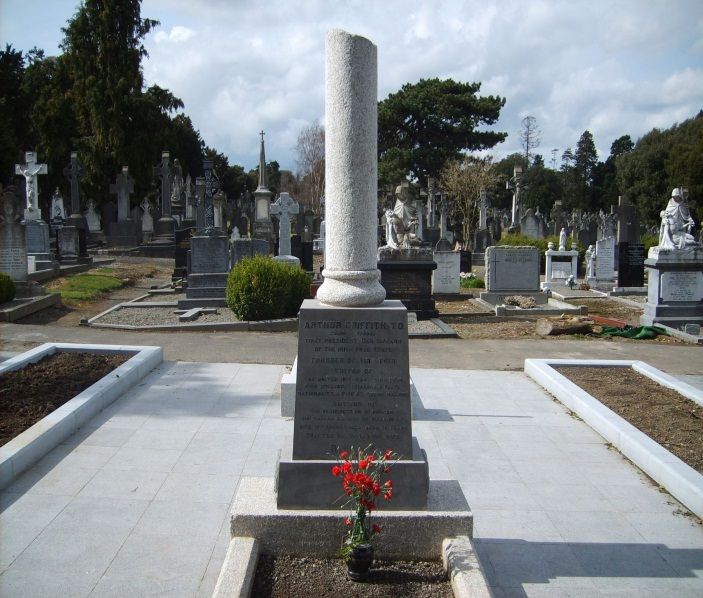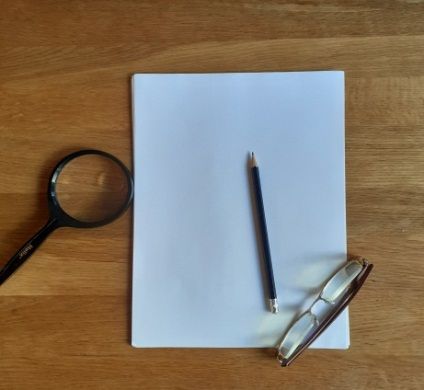An raibh a fhios agat? Did you know?
Arthur Griffith
In 21st century Ireland we are still going through a political time warp which is manifested in our civil-war centred concentration on a two party system. This historical hangover has its origins in the Peace Treaty of 1921 which brought a premature end to over seven hundred years of conflict between Ireland and England. Because of its sequential ramifications, the partitioning of the country being the primary consequence, a civil-war would ensue with opposing sides becoming the pro and anti-Treaty elements that would ultimately morph into the Fine Gael and Fianna Fáil political persuasions that have between them ran the state since its foundation.
Reflecting on the road we have travelled in the interim, it is perhaps for the scholars of today or the critics of tomorrow to adjudicate on the fact that these two political entities have put aside old animosities to cobble together our current administration along with the Green Party. This has had the effect of preventing Sinn Fein from entering office for the first time in the South. Sinn Fein owes its origins in no small manner to one Arthur Griffith. This short overview will look at the contribution of the man and his impact on Irish politics. The party he founded are making a political reincarnation and are becoming more than an irritant in the corridors of political comfort, one might argue.
Introduction
In Ireland at the close of the 19th century the burning issue of the day arguably, was ‘Home Rule’. In effect this would give Ireland some say in the running of its affairs by a parliament in Dublin while being subservient to Westminster. This issue had been at the epicentre of political life for some time with Isaac Butt and Charles Stewart Parnell having carried the torch. The Irish Parliamentary Party with over a hundred seats sat in Westminster and had tried unsuccessfully to bring the Home Rule issue to fruition, being frustrated and subjected to the parliamentary arithmetic of the minority player. In 1902 Griffith would plant a seed that would later have great significance in the sphere of Irish Politics and that was abstentionism. In that he demanded that the Irish parliamentary party refuse to recognize the right of the British parliament to legislate for Ireland. In essence he was advocating their withdrawal from Westminster. His policy direction was one of passive resistance. Ireland through the Act of Union in 1800 was now part of the British Empire. A history of insurrection had been part of the narrative that was euphemistically termed ‘the Irish question’.
The Hungarian model for Ireland.
Griffith had produced a book in 1904 (Wikipedia) in which he drew parallels with Hungary who had sought and achieved a degree of autonomy from Austria but who would tie itself to a dual-monarchy situation. They had in essence their own parliament but would accept the Austrian king as their ruler. At a 1905 Cumann meeting Griffith put this to the assembled as a strategy for Ireland going forward. Emanating from this gathering was the birth of Sinn Fein. The abstentionist policy advocated by Griffith would be the hallmark of the party over the course of its history in its dealing with Britain. Irish MPs would not take their seats at Westminster. In their paper: Going against the Flow: Sinn Fein’s Unusual Hungarian Roots. Hazland and Korkut (2015) , expand on why the Hungarian model could not reflect the political reality in Griffith’s Ireland. Thus the term ‘political transfer’ was not applicable in the Irish context they argue. That said, Griffith did incorporate their position of passive resistance and abstentionism. Although himself a former member of the IRB ( Irish Republican Brotherhood) which would later evolve to become the IRA (Irish Republican Army) he was by all accounts a pacifist.
Sinn Fein. (ourselves alone)
Arthur Griffith was the son of a Dublin printer and staying within the fold earned his keep as a compositor. Of Protestant stock and humble background, he was born on the 31st.March 1871 in Dublin. His fortunes had taken him to South Africa in the 1890s where he spent eighteen months working as a printer and editor. He also took the side of the Boers against what the Irish Central has expressed as British expansionism (accessed 31st Mar 21). With the princely sum of £35 in his pocket on his return to Ireland in 1899 he would set about establishing what would become The United Irishman, a four-page weekly journal with his friend William Rooney. Griffith was also something of a bookworm and spent a lot of his time in the National Library. His circle of intellectual friends started to widen and he found himself joining an increasing number of poets, political figures and scholars among them W, B. Yeats through his journalistic endeavours. In terms of his personal well-being Griffith was a keen swimmer, and enjoyed cycling and traversing Dublin’s hills with his companions. The game of handball was also in his sporting repertoire.
His fledgling journal The United Irishman soon became an eight-page weekly and was attracting contributors of the calibre of Yeats among others. Unfortunately after a few years of perseverance Rooney died leaving Griffith in a sad state of despondency. However, utilizing the experience of youth, Griffith was able to call on his earlier attempts of creativity and the Celtic Literary Society to bring a number of nationalistic organisations, if you would, under one umbrella. The Celtic Literary Society was the brainchild of Griffith and Rooney and spawned from a series of reading clubs and literary societies. From that collective came Cumann na nGaedheal – Society or Association of the Gaels in 1900. The Home Rule issue was again causing consternation within the body politic in Britain; The Prime Minister Gladstone had adopted a conciliatory attitude towards Ireland whilst never going beyond their principle of Empire. However, trouble was in the offing and came to a political climax in 1913. The British Prime Minister then was Asquith.
As the result of a hung parliament in Westminster in 1913 the Irish parliamentarians held the balance of power. The leader of the Irish Parliamentary Party (IPP) was one John Redmond. Sufficient grounds were emerging to suggest that this was the moment for Ireland to achieve its long sought after claim. However, the Unionists viewed this as not in their interests. As a result they established a military force, The Ulster Volunteers to resist any attempt at Home Rule. They imported a huge quantity of arms and ammunition from Germany. In response the Volunteers were formed in the South and set about arming themselves likewise using German armaments but on a much smaller scale. An all-Ireland conflict was looking increasingly ominous but a much bigger conflagration was about to be unleashed on humanity with the first salvoes of World War One (WW1) in 1914.
Home Rule was put on the back burner. Interestingly Griffith took part in the famous Howth gun–running incident when the afore mentioned German weapons for the Southern protagonists were landed in North County Dublin. These weapons would later be used in the Easter Rebellion of 1916.Following the War of Independence in 1919 and the subsequent Truce, the cry for peace was reaching a crescendo. In the South during the War of Independence the IRA, Irish Republican Army had waged a guerrilla war against the crown forces. As a consequence Britain had to maintain a large military and police presence in Ireland to try to keep control of developments. The popularity of Sinn Fein amongst voters was on an upward curve. In the 1918 elections Griffith was elected for East Cavan according to the Irish Central. Irish MPs did not take their seats at West Minster adhering to the Sinn Fein policy of abstentionism.
The first meeting of the Irish government took place in Dublin at the Mansion House in 1919 which was considered an illegal gathering by Britain. In 1920 during the War of Independence Dev Valera travelled to North America on a fund-raising mission with Griffith taking the reins as president. The conflict raged on but talks of peace were gathering pace. The British empire was in a state of flux, WW1 having drained it both in human terms and economically. The Unionists in Northern Ireland were also vehemently opposed to any form of a united Ireland and wanted to maintain the link with Britain. From their perspective the Act of Union in 1800 had copper fastened their position. The path to peace would prove difficult but a Truce was a welcome respite. Seismic events would shape Ireland’s destiny and for some on the political stage would herald the final curtain.
The Treaty negotiations
The negotiations ran from October 1921until December of that year. We know from the well-worn path of historical troupe that Britain assembled a formidable team of experienced negotiators with Lloyd George, Lord Birkenhead, Winston Churchill and Austen Chamberlain among their chief protagonists. The Irish plenipotentiaries were in comparison inexperienced. The Irish team was led by Arthur Griffith with Michael Collins, Robert Barton, Eamon Duggan and Gavan Duffy. Connolly expresses the view that it was expected that Eamon Dev Valera would lead the five-man delegation being as he was an experienced negotiator. However he didn’t attend the negotiations in London. De Valera’s rationale dictated that being head of state he should be kept in reserve. He was also the president of Sinn Fein a position acceded to him by Griffith who had stepped aside.
Lloyd George opened the proceedings with an overview of the situation, declaring his position of the desire for peace but acknowledging both sides ‘red lines’. He also spoke of “the others” or the impossibilists, meaning those at home, in an attempt, according to Coogan (1990 pg.241) to cause division. Griffith’s retort was clear and unemotional, Coogan (1990) continues: “England’s policy in the past has been to treat Ireland as a conquered and subject country. If there is a change in the policy of subordinating Ireland to English interests, then there appears to be a possibility of peace”.
Colm Connolly in his book ‘Michael Collins’ quotes from Tim Pat Coogan who expressed the view that Dev Valera kept absolute control over his cabinet and everything around it. Dev Valera also must have known from his previous interactions with Lloyd George what wasn’t achievable, Coogan opines. The burning question that has been the cause of considerable controversy up to the present day is: did Dev Valera send the delegation to London knowing that they couldn’t achieve the Republic? As he didn’t take an active part in the negotiations did this absolve him of any responsibility in the subsequent agreement that was arrived at? Stemming from the Agreement and it’s passing by the Irish Government in a vote, came the split in parliament. Dev Valera led his TDs from the chamber on that momentous day, the Civil War would follow. Another contentious issue arising from the Treaty was the Boundary Commission. This was to adjudicate on the delineation of the border between North and South. It was thought that over time and with the makeup of the relevant constituencies that more of the affected areas would opt for inclusion in an agreed Ireland. Indeed, according to the Irish News (2021) Griffith had advised Dev Valera of this possibility during the Treaty talks. Despite the best efforts of people like Griffith to find common ground, this wasn’t palpable to Unionism. Ultimately Ireland would obtain dominion status within the UK model with twenty six counties comprising what would ultimately become the Republic of Ireland with six counties maintaining the link with the UK.
Conclusion
The Treaty and the fall-out from it has left an indelible mark on the soul of the Irish subconscious. Historians argue still as to the veracity attached to the notion that De Valera knew that the Irish delegation could not secure a Republic. This is the reason expounded as to why De Velera didn’t attend the talks himself. One might be forgiven for deducing that Griffith who played a pivotal part and guiding influence behind stimulating the debate that brought peace, however imperfect to Ireland, has been largely overlooked in the Republican narrative. It is perhaps worth recalling the words of Griffith:
"What I have signed I will stand by, in the belief that the end of the conflict of centuries is at hand".
Arthur Griffith.
He died prematurely on the 12th August 1922 and is buried in Glasnevin Cemetery Dublin. Three of the major players in this pivotal moment in Irish history, Griffith, Collins and Dev Valera, lie in the hallowed ground of God's acre. Perhaps a more incisive interpretation of Griffith’s contribution to the cause of Irish self-determination might help in re-energising his standing within the narrative of Ireland’s struggle for independence.
Antóin Ó Lochraigh Bard & Soloist
Bibliography
Irish Central. Arthur Griffith Founder of Sinn Fein. Accessed on 31st. Mar 2021.Media/News company.
Connolly.C. Michael Collins. Weidenfeld & Nicolson. London England.
Coogan. T.P. (1990) Michael Collins. A biography. Arrow Books, London. England. ISBN 0 09 968580 9
Coogan. T.P. (195) De Velera. Long Fellow, Long Shadow. Arrow Books, London, England.
Haglund D.G. & Korkut u. (2015) Going Against the Flow: Sinn Fein’s Unusual Hungarian ‘Roots’. The International History Review, Vol. 37, No. 1, 41–58
Keane.M. Plaque of Arthur Griffith.
Moran.S. (2013) Great Irish People. Liberties Press. Terenure, Dublin.
Rock.A. Photos courtesy of Dublin Liberty Tours.
The Irish News. Accessed 2nd April 2021’
Wikipedia. Accessed on 31st.Mar.2021.

What You Can Expect
A walk through Dublin City in the company of a native Dubliner with the emphasis on history, culture and the great Irish ability to tell a story and to sing a song. In addition, and at no extra cost an actual rendition of a self-penned verse or perhaps a spot of warbling. I'd like to share my love of history with you, after all the past is our present and should be part of our future.
About The Tours
Tours are in English, with Irish translations, where appropriate. I also speak Intermediate level Dutch. Duration: 3 hours approx., with a short break in-between. Tour prices and booking options are available in the booking section.
The contact hours are Monday to Sunday, 09:00 - 20:00 IST.
Special Options
We can also arrange a half-day private tour for a maximum of twelve people. This incorporates a collection of parts of our three Tours combined. Tour duration 4-5 hours approx. A break for refreshments in between. Group of 2: €50 per person, Group of 3: €30 p.p., Group of 4 or more: €25 p.p. Refreshments: €10 approx. (This is an extra). Please contact us for details.
Copyright ©2025 Tailteann Tours
Designed by Aeronstudio™




